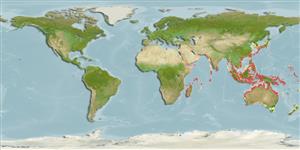>
Beloniformes (Needle fishes) >
Hemiramphidae (Halfbeaks)
Etymology: Hyporhamphus: Greek, hypo = under + Greek, rhamphos = beak, bill (Ref. 45335).
Eponymy: Jean René Constant Quoy (1790–1869) was a French naval surgeon and zoologist who named many species, often with Joseph Paul Gaimard (q. [...] (Ref. 128868), visit book page.
More on author: Valenciennes.
Environment: milieu / climate zone / intervalo de profundidade / distribution range
Ecologia
marinhas; Água doce; estuarina pelagic-neritic; intervalo de profundidade 0 - ? m. Tropical
Indo-West Pacific: in western Pacific, known from Thailand, the East Indies, Borneo, and the Philippines north to China and Nagasaki, Japan, south to New Guinea and northern half of Australia.
Length at first maturity / Tamanho / Peso / Idade
Maturidade: Lm ?, range 13 - ? cm
Max length : 31.2 cm SL macho/indeterminado; (Ref. 9843)
Espinhos dorsais (total) : 0; Raios dorsais moles (total) : 14 - 17; Espinhos anais: 0; Raios anais moles: 13 - 17; Vértebras: 51 - 56. Prolonged, beak-like lower jaw, shorter than head length, its length contained in 4.7-8.6 times in SL and 1.2-2.0 times in head length; upper jaw short, scaly, blunt and rounded, its width contained in 0.5-0.6 times in its length; preorbital bone 1.75-2.15 times in diameter of orbit and 0.9-1.15 times in length of upper jaw; preorbital ridge present; posterior branch to preorbital lateral line canal present. Total number of gill rakers on first arch 26-39; dorsal fin rays 14-17, usually 16; anal fin rays 13-17, usually 15 or 16. Caudal fin forked, with lower lobe longer than upper.
Body shape (shape guide): elongated.
Inhabits more turbid and estuarine situations than does Hyporhamphus dussumieri and is not found in oceanic islands (Ref. 9843). May enter rivers (Ref. 559). Found in medium to large-sized rivers of the lower Mekong (Ref. 12975). Occurs in schools (Ref. 3132). Taken mostly with shore seines; marketed mostly fresh and dried salted (Ref. 9843).
Life cycle and mating behavior
Maturidade | Reprodução | Desova | Ovos | Fecundidade | Larvas
Collette, B.B. and J. Su, 1986. The halfbeaks (Pisces, Beloniformes, Hemiramphidae) of the Far East. Proc. Acad. Nat. Sci. Philadelphia 138(1):250-301. (Ref. 10943)
Categoria na Lista Vermelha da IUCN (Ref. 130435: Version 2025-1)
Ameaça para o homem
Harmless
Utilização humana
Pescarias: pouco comercial
Ferramentas
Relatórios especiais
Descarregue XML
Fontes da internet
Estimates based on models
Preferred temperature (Ref.
123201): 24.1 - 29.3, mean 28.4 °C (based on 3099 cells).
Phylogenetic diversity index (Ref.
82804): PD
50 = 0.5000 [Uniqueness, from 0.5 = low to 2.0 = high].
Bayesian length-weight: a=0.00234 (0.00129 - 0.00425), b=3.08 (2.92 - 3.24), in cm total length, based on LWR estimates for this species & Genus-body shape (Ref.
93245).
Nível Trófico (Ref.
69278): 3.0 ±0.0 se; based on diet studies.
Resiliência (Ref.
120179): Elevada, tempo mínimo de duplicação da população menor que 15 meses (Preliminary K or Fecundity.).
Fishing Vulnerability (Ref.
59153): Low to moderate vulnerability (28 of 100).
🛈
